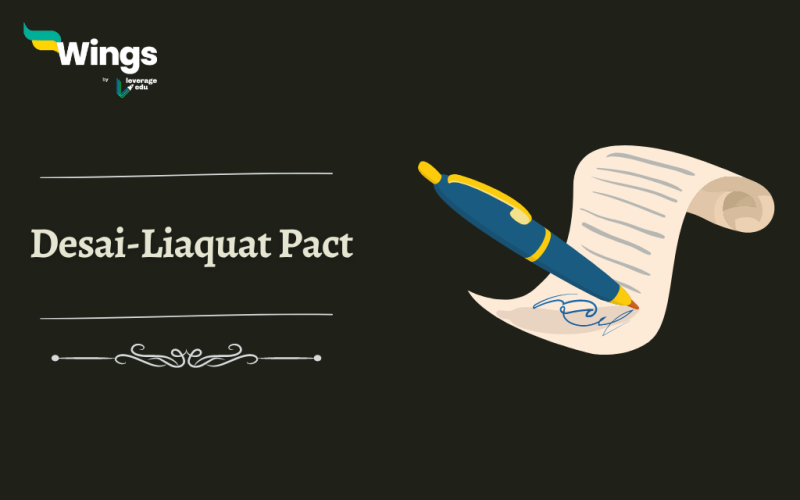The Desai-Liaquat pact for peace plays an integral role in the Post-independence history of India. It was a bilateral agreement signed on April 8, 1950, by the then-Prime Minister of India, Jawaharlal Nehru’s envoy, V.K. Krishna Menon, and Pakistan’s Prime Minister, Liaquat Ali Khan. It is also known as the Delhi Agreement which aimed to address the issue of minority rights and safeguard the religious and cultural rights of both the communities involved and other communities in a diversified nation. As the name suggests this pact was a significant attempt at building and promoting peace for all communities following decolonization in 1947. However, it came with its own set of challenges in combining the now Pakistan and India.
| Date | April 8, 1950 |
| Reason | Formation of Interim Government at the Centre |
| Participants | Congress Leader Bhulabhai Desai and Liaquat Ali, Leader of the Muslim League) |
Table of Contents
Who was Bhulabhai Desai?
Bhulabhai Desai (13 October 1877 – 6 May 1946) was an acclaimed lawyer and one of the Indian independence activists. In his 40 years of career in court, he has fought a lot of high-profile cases, one of which are Indian National Army trials, in 1945. The reason that he is very well known amongst people to date is that he defended the three soldiers from the Indian Army who were accused of treason in World War II. Moreover, he attempted to negotiate the Desai-Liaquat pact for peace with Liaquat to get the help of the Muslim League in releasing his fellow congressmen from jail.
Who was Liaquat Ali?
Liaquat Ali Khan (Oct. 1, 1895-Oct. 16, 1951) was the first Prime minister of the independent Pakistan from 1947 to 1951. His leader was Muhammad Ali Jinnah and just like him, Liaquat was also a barrister by profession. Soon after joining politics in 1923, he joined the Muslim League to get in touch with his idol Jinnah. It is said that if Pakistan was made by Jinnah, Liaquat Ali Khan was the one who laid the right foundation for the nation.
Background of the Desai-Liaquat Pact for Peace
- The “Quit India Movement” was initiated by Mahatma Gandhi on 9 August 1942 and it lasted 3 years till 1945. It aimed to end British rule in India and the ending of this movement was the announcement of Congress as an unlawful association.
- Many leaders throughout the nation were arrested and with this began a chaotic movement. While many of them were behind bars, among the few Congress leaders who were free, Desai was one of them.
- He was doing everything on his end to release his fellow political leaders when he met Liaquat Ali Khan who was also the second most important leader of the All-India Muslim League.
- This is when the two parties agree on a certain set of rules for the future coalition of the two most important parties which would ultimately end the two communities’ bridge and work under the same umbrella.
Proposals of the Desai-Liaquat Pact for Peace
The Desai-Liaquat Pact for peace came with certain important proposals that must be followed by both the parties involved or at least unknowingly involved. Liaquat Ali Khan and Bhulabhai Desai made proposals for building an Interim Government at the center.
After agreeing with Desai’s ords, Liaqat made a full-fledged declaration list that was supposed to be followed which are as the following:-
The central executive will witness an equal number of nominated persons from both communities.
Minorities would be represented or acknowledged, specifically Scheduled Caste and Sikhs.
A new government should be formed and work within the existing framework of the Government of India Act, of 1935.
Impact of the Desai-Liaquat Pact for Peace
This pact was initiated by Desai without the prior knowledge of Mahatma Gandhi and Jawaharlal Nehru, the prominent leaders of India, likewise from the end of Liaquat Ali it was not mentioned to Muhammad Ali Jinnah, the leader of the Muslim League. Both the parties got to know about the Desai-Liaquat Pact for Peace only at the press conference which obviously created chaos in the peace and the leaders involved disagreed with this pact.
- Bhulabhai Desai- This decision was heavy on Bhulabhai Desai because he was unallowed from constitutional assembly elections later on the reasons his health was blamed for not standing on the former elections. Moreover, he was also blamed for losing the war budget which led to his removal from the party. It ultimately damaged his political career.
- Liaquat Ali- On the other hand, Liaquat Ali, denied any such pact. He mentioned that all of it was just a story and that it was not implemented on any level from his end.
For all these unavoidable reasons, the Desai-Liaquat Pact for peace came to an end. It was just the pact that came to fill the vacuum when most of the Indian leaders were in jail for a good cause. Congress party which was announced unlawful could not take any risk of insensitive rumor at the most crucial stage of its reputation post-independence.
FAQ
He was assassinated in 1951, and Khawaja Nazimuddin took office.
People with the Desai surname are usually of the Anavil Brahmin or Vaishnav Vanik sub-caste.
Yes! The Desai-Liaquat Pact for Peace was also known as the Delhi Agreement because it happened in Delhi.
It aimed to protect the rights and security of minority communities in both countries. However, it was not officially accepted by the parties involved in it.
Related Blogs
This blog was all about the Desai-Liaquat pact for peace. If you want to read more articles like this, you can get Short notes on the Modern History of India here. Also, you can visit our general knowledge page on Indian History!
 One app for all your study abroad needs
One app for all your study abroad needs













